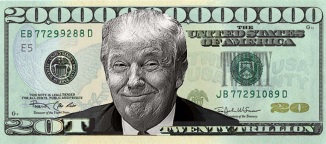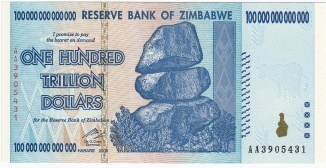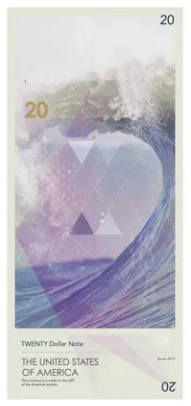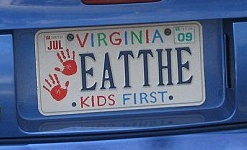 here's been much discussion, much of it politically charged, about whether to replace
President Andrew Jackson with Harriet Tubman on the US twenty-dollar bill. I know
everyone on the Internet is just dying to hear my opinion, so here it is.
here's been much discussion, much of it politically charged, about whether to replace
President Andrew Jackson with Harriet Tubman on the US twenty-dollar bill. I know
everyone on the Internet is just dying to hear my opinion, so here it is.
The attentive reader will note that this website rarely posts an image of an actual person: the only (formerly) living things at the moment are Karl Marx, a cow, and a woodpecker. Make of that what you will. Oh, and a cat, but that's just a hat tip to the Internet, which (and surprisingly few people are aware of this) is actually run by the evil cat oligarchy.

Donald J. Trump 20 trillion dollar note

Zimbabwe hundred trillion dollar note
Suppose some day we were to put Donald J. Trump on the currency. A Trump twenty trillion dollar note would demonstrate wealth, self-confidence, and American brashness. Some people will like it; others will hate it. But as nice as it may be, a Trump Twenty Trillion note would have a fatal flaw: it's a portrait.
The argument for portraits was that humans are programmed to recognize slight differences in faces, which made it harder to create forgeries. But that argument is no longer valid. Nowadays holograms, computer chips, and encryption codes are orders of magnitude harder to forge.
The argument against portraits is that America is not its leaders. Americans aren't loyal to individuals but to the land and the ideals that we all share. Substituting one person for another, whether it's Donald Trump, Harriet Tubman, or Teddy Roosevelt would not accomplish the change we need.
Zimbabwe, of all places, has shown us the way. Most of Zimbabwe's bank notes (they produced only paper, no coins), including its 100 trillion dollar bank note which, thanks to the magic of inflation, is equal to 1027 (1,000,000,000,000,000,000,000,000,000) pre-2006 dollars, feature a pile of three balancing rocks.
Travis Purrington has some truly beautiful ideas along these lines, including a Twenty depicting water and foam. It's modern, artistic, elegant, and hopefully not copyrighted (see image at right).

Travis Purrington's proposed twenty dollar bill
Or how about something that truly symbolizes capitalism? The feds could probably balance their budget by selling space on the Twenty, just as it sells radio frequencies. (It would also make more sense than claiming ownership of the electromagnetic spectrum.) The Pepperidge Farm Goldfish® Five might become a collector's item, while the Exxon Mobil Twenty could inform us about Exxon Mobile Synergy™ fuel technology, with its seven key ingredients (two detergents, a corrosion inhibitor, an anti-adhesion compound, an emulsifier, a solvent fluid, marker molecules, and fuel).
But why stick with static images? We already have fluorescent plastic strips. With modern technology, we could have an animated gif, like the Exxon emulsifier guy whose arm flies up and down exactly twice a second. With a sufficiently advanced AI chip, we could even have an e-paper bill that speaks to the blind, narrating interesting facts about the national debt and the current dollar-yen exchange rates. Or we could make them functional by integrating a solar panel into each dollar bill.
Of course, I'm being facetious. Using a portrait as a symbol in this age of identity politics just creates problems. People will say: we need an American Indian, a person with Down syndrome, or a farmer. Why discriminate against creative people like Henry Ford or Thelonious Monk? Once the door is opened, it is an endless source of contention.
The introduction of theme license plates shows what I mean. They rapidly became a forum for making personal statements. Some times they were amusing, like the famous Virginia “EatThe Kids First” plate. Other times they became political, contentious, and vulgar. Therefore, most states forbid messages about issues like abortion and firearms because they would be seen as advocacy by the state for one side or the other, which is unacceptable in a representative democracy.
Whether it's Susan B. Anthony or Sitting Bull, Harriet Tubman or Frank Zappa, putting somebody's portrait on the currency is going to satisfy one group of people and offend another. Picking an individual to symbolize some cause, even if everyone agrees it's a good cause, favors one cause over another. And where would it end? Does the Red Cross deserve a spot? The military? The Chicago Cubs? The government should not be taking sides—it is uncomfortably close to telling us what to believe.

Eat the kids first license plate
If we must have portraits, they should be ordinary people, not politicians or symbols of somebody's political cause, no matter how noble it may be. For example, each Twenty could have an image of a different beloved American cultural figure along with their favorite saying.
Edgar Allan Poe: I became insane, with long intervals of horrible sanity.
Snoop Dogg: A lot of people like to fool you and say that you're not smart if you never went to college, but common sense rules over everything. That's what I learned from selling crack.
Bill O'Reilly: You know what's really frightening? You actually have an influence on this presidential election. That is scary, but it's true. You've got stoned slackers watching your dopey show every night and they can vote.
Soon our currency will be replaced with implanted microchips and paper money will be printed mainly for collectors. But for now currency is a functional thing that we're all forced to use. Don't turn it into a type of vanity license plate. Portraits are political, and the last thing we need is politics on our currency.
sep 01, 2017; last substantive edit sep 07, 2017, 7:06 am

